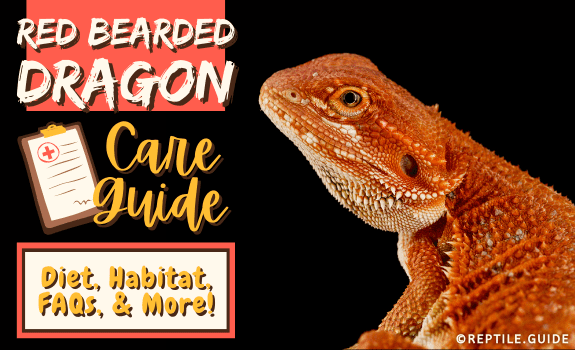The red bearded dragon is a classic color morph of the central bearded dragon.
They grow to the same size as most bearded dragons and have the same care needs.
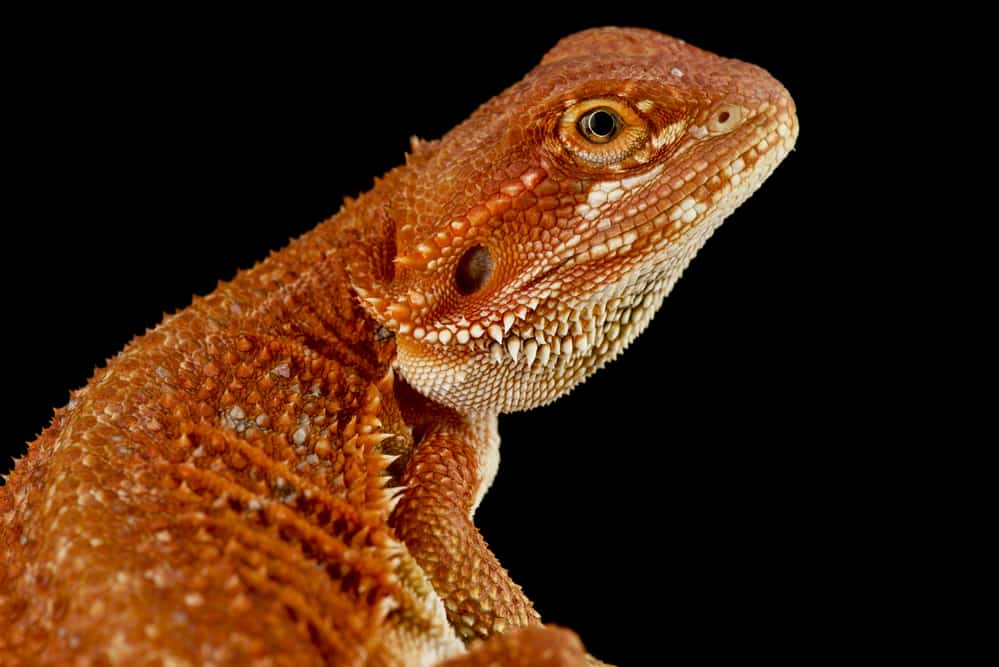
In This Article
How Much Does a Red Bearded Dragon Cost?
You can expect to pay anything from $200 to $900 for red bearded dragons.
Red bearded dragons vary in price, depending on the morph you buy. Average prices for some of the morphs include:
- Standard red – $200-300
- Hypo red bearded dragon – $200
- Super red bearded dragon – $270
- Super red leatherback bearded dragon – $400
These aren’t the only red morphs, but they give you an idea of the prices involved. The fancy bearded dragon morphs cost much more than the standard morphs.
Where to Buy Young Bearded Dragons
There are many places where you can buy a baby red bearded dragon.
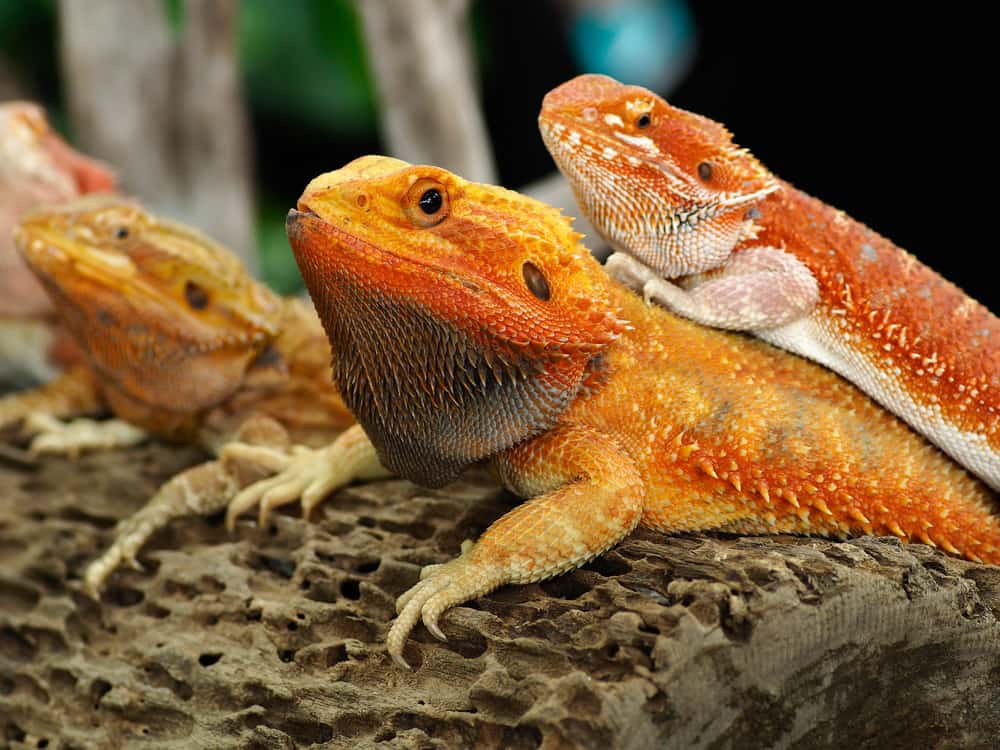
Some of the best options include:
- Repticon – You can buy red bearded dragons at almost every reptile convention (Repticon) or expo.
These conventions host hundreds of breeders from across the United States. It’s an excellent place to meet other hobbyists, and buy animals direct from their breeders.
This is advantageous because you can get advice straight from the breeder.
The organizers of the expo, vet every breeder to ensure they are providing a quality service.
- Online Marketplaces – Many online marketplaces, like Morphmarket, sell morphs of the Central bearded dragon, Pogona vitticeps.
If you’re looking for a fancy bearded dragon like a super red or German giant, it’s an excellent place to look.
You may also find standard morphs and other bearded dragons. The marketplaces offer legal support for buyers and screen all the breeders carefully.
The courier company will deliver the bearded dragon directly to your door.
- Buying Directly From Breeders – Many breeders sell bearded dragons, and you can often buy the red morph directly from them.
Most sellers that don’t work through the online marketplaces have websites or sell through forum groups.
Ensure that the breeder is trustworthy, by researching them on review sites.
You can also check with users on reptile forums to see if they’ve had any experiences with the breeder.
Buying directly from the breeder is a good way of getting quality stock.
How Big Does a Red Bearded Dragon Get?
The red morph of the bearded dragon grows to lengths of between 16 and 24 inches. Apart from their coloration, these beardies are no different from other bearded dragons.
As with most other morphs of Pogona vitticeps, this morph is no larger or smaller than standard bearded dragons.
Red Bearded Dragon Enclosure Setup
Red beardies are the same size as other beardies and have the same needs. You can easily keep a hatchling in a 10-gallon aquarium.
An adult will need at least a 55-gallon enclosure. Check out our article about bearded dragon tanks for more details.
The following sections will explore the enclosure needs of a red beardie.
Substrate
Finding the right substrate for your beardie is essential. These reptiles often eat their substrate unintentionally in pursuit of insects or other food.
You need a substrate that won’t cause impactions or a setup that keeps the risky substrate away from the food area.
Let’s take a closer look at some of the options:
- Sand – Few keepers like using sand for their pets. They fear impaction since sand can easily cause it.
However, sand is one of the most natural substrates for beardies. These animals are desert animals, and would naturally live in sandy areas.
It’s easy to solve the impaction issue by keeping one-third of the enclosure clear of sand. This area is the feeding area, where you keep the beardie’s feeding bowl.
- Bark Chips – A bark product like Reptibark or orchid bark works well for beardies. The chunks are too large to swallow.
The bark can also maintain humidity levels without pushing them too high.
- Ceramic Tiles – Ceramic tiles are a common choice as beardie substrate.
You’d need a single box to cover the base of most aquariums, and they’d last for the animal’s lifetime.
You can easily remove the tiles and wash them when needed. The tiles also give the bearded dragon grip, allowing them to walk comfortably.
- Alfalfa Pellets – Alfalfa pellets are an excellent substrate choice. Since they consist of greenery, they’re unlikely to cause a blockage.
They’re also more natural than a bare tank or something like ceramic tiles. However, they can also cause much higher humidity levels.
- Reptile Carpet – Reptile carpet is one of the most popular substrates for these reptiles.
This substrate looks like fake grass or a thick brown rug. It’s easy to clean, and affordable.
Since you can wash it, it has a long lifespan. You won’t need to replace it more than once or twice in your pet’s life.
- Rubber Shelf Liners – The rubber shelf liners that you use to line closet shelves work well as a substrate for your pet lizard.
They provide grip, and you can easily wash them when cleaning the enclosure.
- Newspaper or Paper Towels – Using paper products is another popular choice among beardie owners.
It’s affordable, sustainable, and easy to replace when it gets soiled.
Pro Tip: You don’t have to stick to one substrate type. Mix and match till you find a mix that works for you and your pet.
Temperature and Humidity
These lizard pets come from subtropical deserts and need high temperatures. You can aim to provide the following temperature gradient:
- Cool side – 70-75°F
- Basking spot – 120-130°F
- Ambient temperature – 85°F
- Night-time temperature – 60-70°F
Like all reptiles, beardies can’t control their body temperature internally. Your red bearded dragon needs a temperature gradient so it can control its temperature.
This is easily accomplished by heating only one half of the enclosure and leaving the other at room temperature.
Your bearded dragon will move between the cool and warm areas to help keep its body temperature in the optimal range.
These animals come from dry areas. Try to maintain a relative humidity of 30-40.
You can use a set of thermometer-hygrometer combos to help you track the conditions. Having one on each side will help you monitor temperature and maintain humidity.
Heating and Lighting
As with most pet reptiles, heating and lighting are essential for your beardie’s well-being.
There are many different ways to heat a bearded dragon enclosure, including:
- Heating pads – Under-tank heating pads offer an excellent option for heating your pet lizard at night.
Since they don’t produce light, mats won’t interrupt your reptile’s day and night cycle.
You can also use heating pads, and a thermostat, to keep the enclosure temperatures in range in cold areas.
A thermostat will automatically adjust the device so you don’t have to monitor temperature as closely.
- Heating lamps – Heating/basking lamps are one of the most practical tools for heating your pets during the daytime.
Since they produce light, you can’t use them at night. It will destroy your dragon’s day and night cycle.
- Ceramic heat emitters – Ceramic heat emitters are much like heat lamps, but they don’t produce light.
You can use them instead of, or in addition to, heat lamps. We recommend using them for nighttime heating.
Of all the heating options on the market, heating lamps and heat emitters are the most natural.
Reptiles naturally get their heat from above, through sunlight. Lamps offer the type of heating that’s closest to that ideal.
Your bearded dragon needs lighting to keep it healthy. The most important part is ensuring that it has a day and night cycle.
Whichever light you use, ensure that it burns for 12 hours a day, and is off for 12 hours a day.
UVB lighting is essential for bearded dragons. It helps them to absorb calcium into their bloodstream and prevents metabolic bone disease.
If you’re using heat lamps, you can simply buy UVA and UVB bulbs for your heat lamp. If you’re using one of the other heating options, you’ll need to buy a fixture to take UV lights.
You’ll need to replace UV bulbs every four to six months, after which time they produce fewer UV rays.
Hides and Decor
Beardies don’t require much in the way of decoration, but they do appreciate some additions to their enclosures.
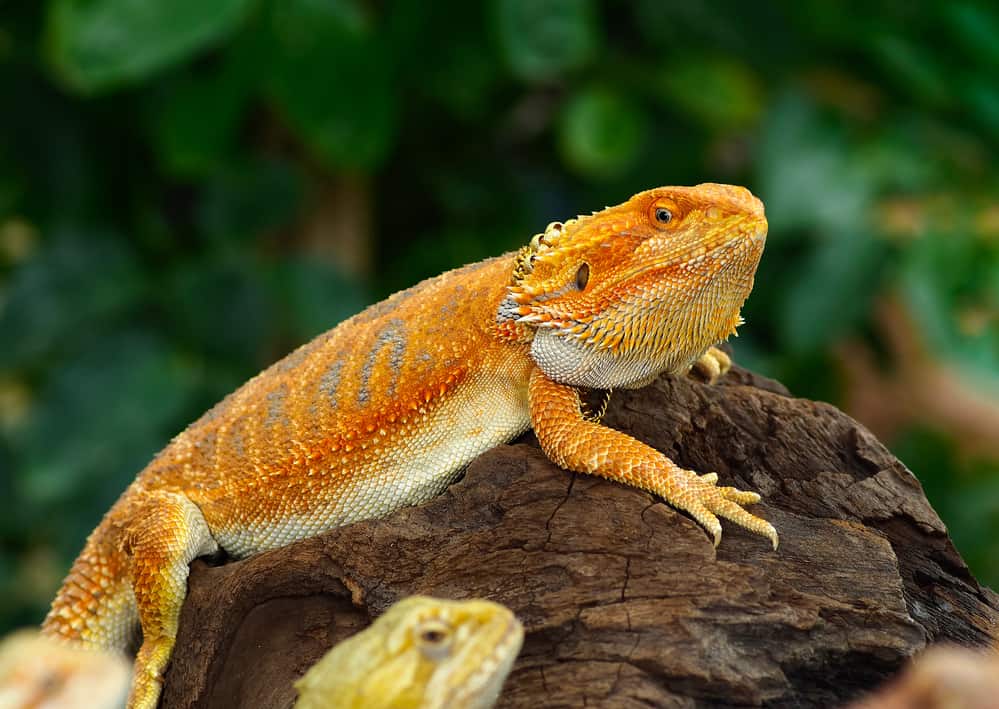
The most essential elements include:
- Hides – Each beardie needs at least two hides, one on each side of the enclosure.
Options include custom-made hides, plastic shoeboxes, and ceramic flowerpots. Hides give them the sense of security they need to live stress-free lives.
- Bowls – Giving your beardies a large, shallow water bowl serves three purposes:
- It allows the beardie to soak
- It helps maintain the humidity levels
- It gives the beardie a place to drink water
- It helps to contain insects and prevent impactions
- Climbing surfaces – While beardies are terrestrial, they appreciate having driftwood, rock, or other surfaces to climb on.
What to Feed a Red Bearded Dragon
All bearded dragons need a similar diet. Adults need 80% vegetable matter and 20% live food. Babies need 80% live food and 20% vegetables.
Fruit is also an essential part of their diet, as it contains different minerals and nutrients. However, It’s not as important as the other two elements.
A baby bearded dragon’s diet should contain no more than 5% of fruit, and an adult dragon’s no more than 15%.
Vegetables
When planning a diet for bearded dragons, safe vegetables to use include:
- Okra
- Kale
- Basil
- Leek
- Squash
- Radish
- Arugula
- Parsnip
- Cabbage
- Pumpkin
- Bok choy
- Zucchini
- Asparagus
- Bell pepper
- Turnip greens
- Collard greens
- Mustard greens
- Peeled cucumber
- Dandelion greens
- Raw artichoke heart
Live Foods and Insects
Live foods and insects you can use include:
- Locusts
- Crickets
- Redworms
- Mealworms
- Silk worms
- Earthworms
- Super worms
- Dubia roaches
- Black soldier fly larvae (phoenix worms)
Of these, foods like dubia roaches and crickets are the healthiest. They contain more protein and less fat.
Avoid feeding your dragon waxworms as they have a high fat content. Only give them mealworms in moderation, for the same reason.
Fruits
Many fruits are good for your dragon, including:
- Figs
- Guava
- Peaches
- Pears
- Plums
- Mangoes
- Papaya
- Apricots
- Blueberries
- Cranberries
- Watermelon
- Blackberries
- Strawberries
- Peeled apples
- Pitted cherries
- Seedless raisins
- Green & red grapes
- Honeydew & cantaloupe melon
Supplements
Beardies have a high calcium requirement, which means you should always use a high-quality calcium supplement for bearded dragons.
It’s a good idea to seek veterinary advice to find out if your dragons need any additional supplements.
In some cases, beardies need a full vitamin and mineral supplement rather than just calcium.
Types of Red Bearded Dragons
The red dragon lizard has been around long enough for there to be several types.
Different shades of red, different types of scales, and different sizes all feature in the red morph.
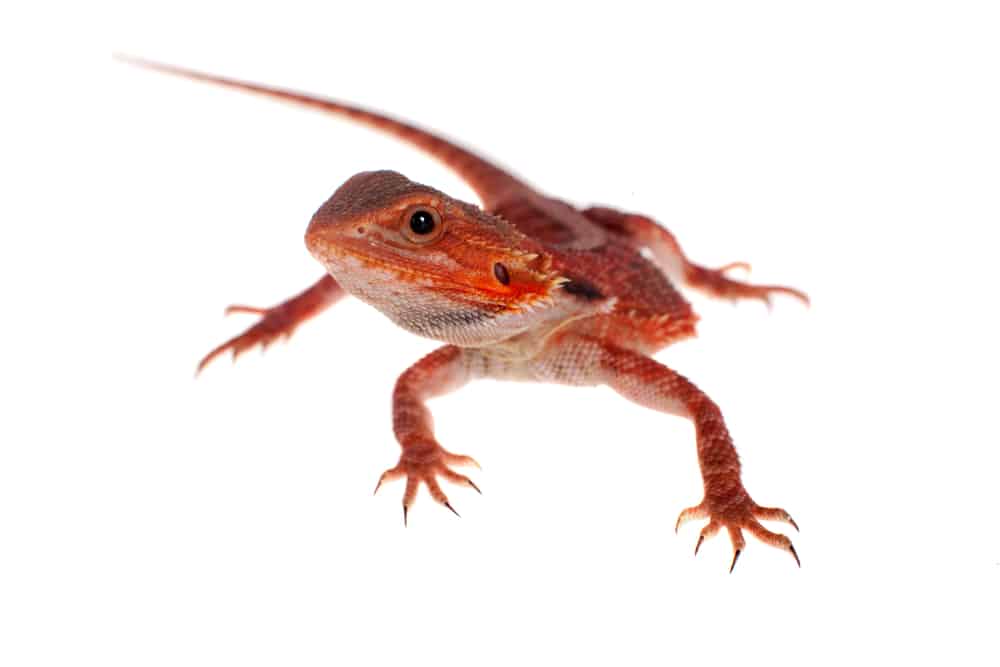
Crosses with the German Giant morph have created much larger animals than the red lizards that came before.
By breeding red beardies with silkback and leatherback types, many types of scales have emerged as well.
Breeding this type of beardie with hypos, and other morphs is responsible for the different shades we see today.
The following sections will take a closer look at some of the most-loved red beardie morphs.
Red Leatherback Bearded Dragon
The leatherback beardie doesn’t have the spikes that most beardies have on their backs. An absence of spikes has led to smooth skin, much like leather.
By breeding other types with the leatherback, keepers have produced more than one red morph.
You can buy an array of red leatherbacks, including:
- Red leatherback
- Hypo red leatherback
- Super red leatherback
Keep your eyes open for new red leatherback types, as breeders continue creating new types.
Hypo Red Bearded Dragon
The hypo red beardie is a morph that results from crossing the red and hypo morphs.
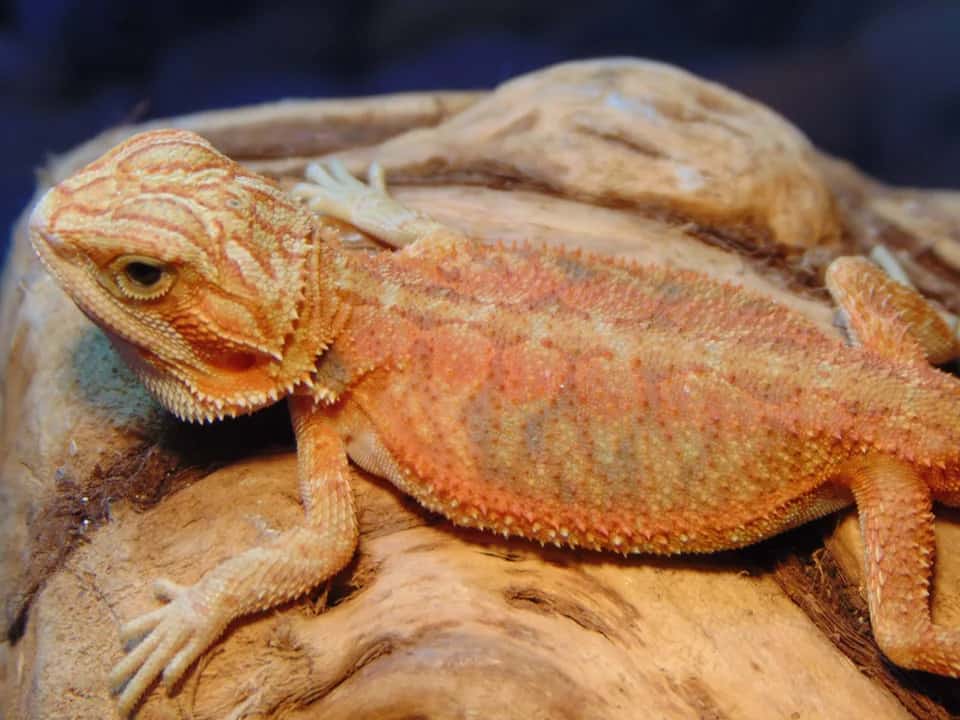
Image credit: u/Kadditz (via Reddit.com)
Hypo (short for hypomelanistic) beardies have much less melanin than most dragons. This makes them look somewhat washed out.
When combined with the vibrant red, these animals are truly striking. You may also find variations of these beardies, like super hypo red.
Super Red Bearded Dragon
As is the case with other reptiles, a super morph inherits the gene for a certain characteristic from both parents.
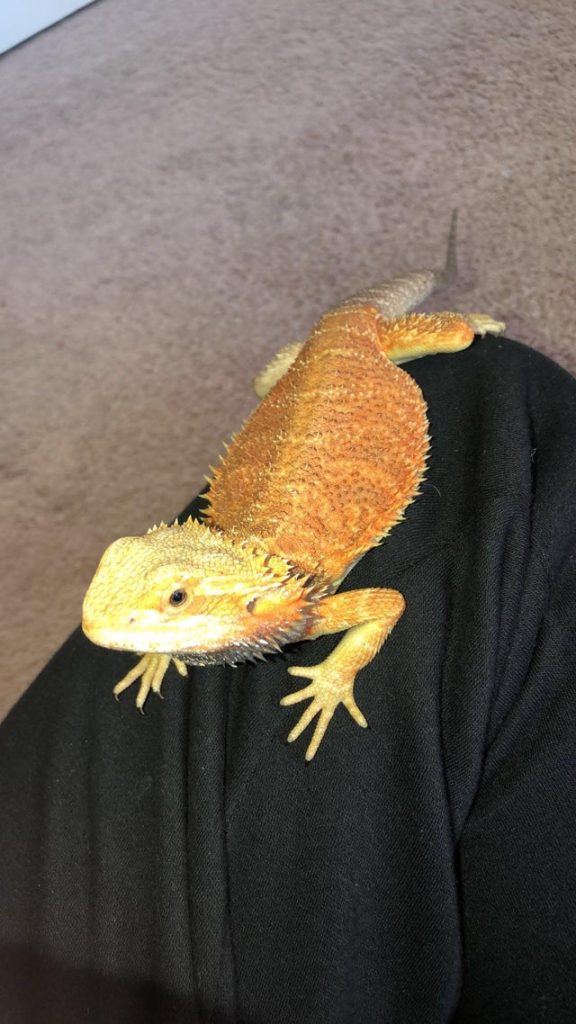
Image credit: u/dpruetz (via Reddit.com)
In a standard red morph, the beardie inherits one red gene from each parent. In a super morph, the beardie gets two red genes from each parent.
These beardies are excellent for breeding, and will always give the red gene to their descendants.
Breeders often use supers to create new morphs that include the red gene.
While rumors of a blue flame red bearded dragon are making the rounds, we’re yet to see proof that they exist.
We hope you’ve enjoyed this article about the red bearded dragon. As we mentioned, their care is much like any other beardie.
For even more detailed care instructions, check out our comprehensive care guide.
What do you plan on naming your new red beardie? Let us know in the comments.
